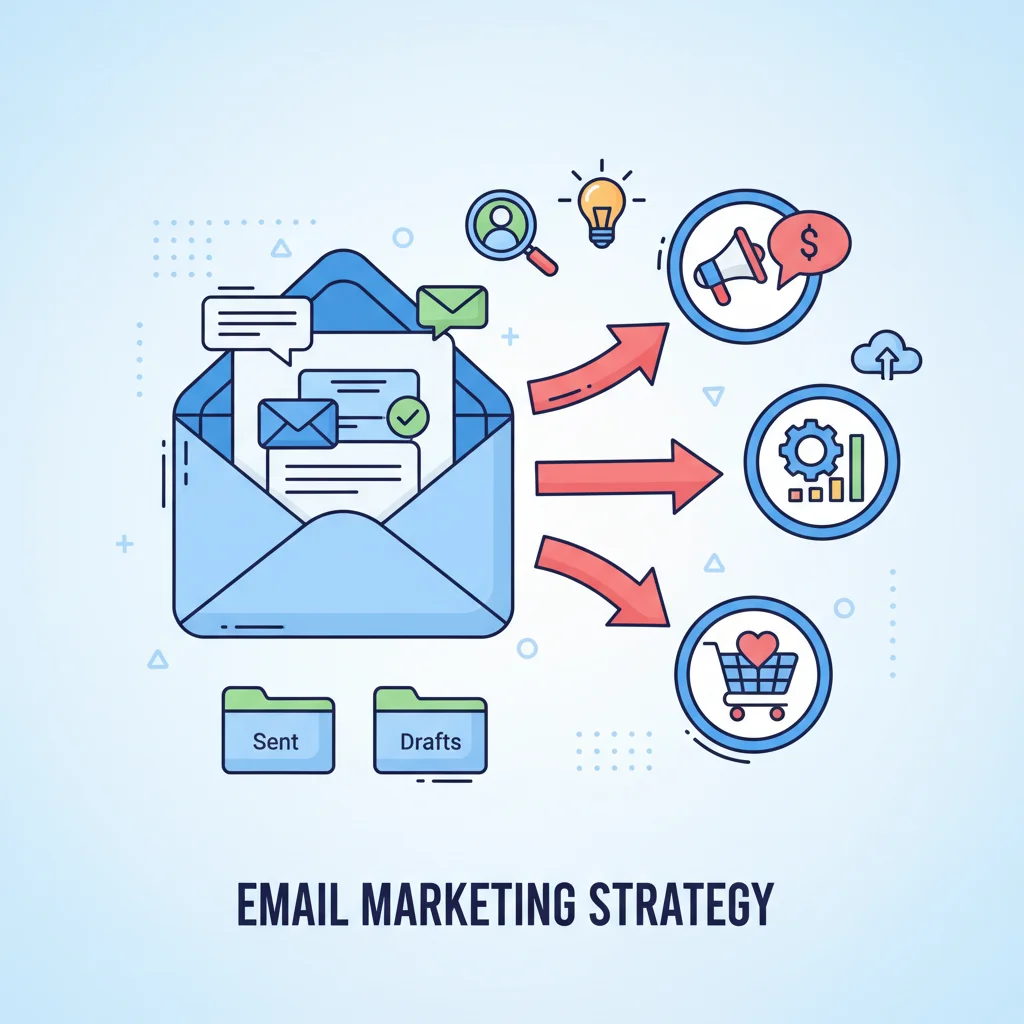Now Reading: What is A/B Testing in Email Marketing and How to Use It?
-
01
What is A/B Testing in Email Marketing and How to Use It?
What is A/B Testing in Email Marketing and How to Use It?

Did you know that 75% of top online retailers use A/B testing in their email marketing? They’re not just guessing what works-they’re systematically discovering it. And today, I’m pulling back the curtain on how you can do the same, even without a big marketing team.
Key Takeaways
A/B testing in email marketing is a method of comparing two versions of an email with one varying element to determine which performs better. Here’s what you need to know:
- A/B testing (also called split testing) involves sending two email variations to different segments of your audience to see which drives better results
- You should only test one element at a time-like subject lines, CTAs, or send times-to clearly identify what impacts performance
- The process follows four key steps: set clear goals, form a hypothesis, conduct the test, and implement findings
- For reliable results, ensure you have a large enough sample size and run tests for at least two weeks
- Continuous testing leads to incremental improvements in open rates, click-throughs, and conversions over time
What Is A/B Testing In Email Marketing?
Ever sent an email campaign that flopped and thought, “if only I knew what went wrong”? That’s exactly the problem A/B testing solves.
A/B testing in email marketing is a straightforward but powerful method where you create two versions of an email, changing just one element, and send them to different segments of your audience to see which one performs better.
Think of it as a mini-experiment for your emails. Instead of guessing what your subscribers want, you’re gathering actual data about their preferences.
The beauty of A/B testing is its simplicity. You’re not reinventing the wheel-you’re just making small, strategic tweaks and measuring the impact. And those small tweaks can lead to big results.
For example, a simple subject line test might reveal that using emojis increases your open rates by 25%, or that question-based subject lines outperform statement-based ones for your specific audience.
Why A/B Testing Matters
I’ll be honest-skipping A/B testing is like throwing darts blindfolded. You might hit the target occasionally, but you’re mostly just hoping for the best.
With A/B testing, you’re:
- Making data-driven decisions instead of relying on hunches
- Learning exactly what resonates with YOUR audience (not someone else’s)
- Continuously improving your email performance over time
- Maximizing ROI from your existing subscriber list
- Staying competitive with top brands who already use this strategy
Did you know that some 75% of the top 500 online retailers use split testing? That’s because it works. It’s your chance to step into the big leagues and create email campaigns that don’t just get sent but actually succeed.
Useful Articles:
How To Set Up An A/B Test For Email Marketing
Setting up an A/B test doesn’t have to be complicated. Here’s how to do it right:
Step 1: Set Clear Goals
Before you start testing, you need to know what you’re trying to improve. Are you aiming for:
- Higher open rates?
- Better click-through rates?
- More conversions?
- Reduced unsubscribe rates?
Pick ONE metric to focus on. If you’re struggling with low open rates, then subject lines should be your testing priority. If emails are being opened but links aren’t being clicked, focus on testing your CTAs or email content.
Establish both your current benchmark (where you are now) and a realistic target (where you want to be). For example, “Increase open rates from 18% to 23%.”
Step 2: Form A Hypothesis
Now, develop a specific hypothesis about what might improve your chosen metric. Your hypothesis should be concrete and testable.
For example:
- “Including the recipient’s name in the subject line will increase open rates”
- “A red CTA button will get more clicks than a blue one”
- “Sending emails on Tuesday morning will result in higher open rates than Friday afternoon”
The key is to be specific about what you’re changing and what result you expect to see.
Step 3: Create Your Test Variations
This is where you create your two email versions. Remember the golden rule of A/B testing: change only one element at a time.
If you change multiple elements, you won’t know which change caused the difference in performance.
Here’s what your test might look like:
- Version A: “Summer Sale: 20% Off Everything”
- Version B: “Summer Sale: 20% Off Everything Ends Tonight!”
Everything else in the email should be identical-the same content, images, CTAs, and send time. The only difference is the added urgency in Version B’s subject line.
Step 4: Select Your Test Group
Most email marketing platforms allow you to send your test to a percentage of your list first, then automatically send the winning version to the remainder.
A good rule of thumb:
- For small lists (under 5,000 subscribers): Test with 25-50% of your list
- For larger lists: 10-25% is usually sufficient
Make sure your test groups are randomly selected and large enough to provide statistically significant results.
Step 5: Run The Test And Analyze Results
Send your test emails and give them enough time to gather meaningful data. For most tests, 24-48 hours is sufficient, but for some metrics like conversion rate, you might need longer.
When analyzing results, look for:
- Statistical significance (most email platforms will calculate this for you)
- The size of the difference between versions
- Whether the results confirm or contradict your hypothesis
Don’t just look at which version “won”-try to understand WHY it performed better.
What Elements To Test In Your Email Campaigns
The possibilities for testing are nearly endless, but here are the most impactful elements to focus on:
Subject Lines
Subject lines are the gatekeepers of your email-if they don’t entice opens, nothing else matters. Here’s what you can test:
- Length: Short vs. long subject lines
- Personalization: Including the recipient’s name vs. generic
- Tone: Professional vs. casual
- Questions vs. statements
- Using numbers or statistics
- Including emojis vs. text-only
- Creating urgency (“Limited time”) vs. no urgency
Example test:
Version A: “Your May Newsletter”
Version B: “5 Trends You Can’t Afford to Miss This Month”
Preheader Text
That little snippet of text that appears after the subject line in most email clients is prime real estate. Test:
- Complementing vs. extending your subject line
- Including a call to action in the preheader
- Using personalization elements
- Length of preheader text
Sender Name
Who the email appears to be from can significantly impact open rates. Test:
- Company name vs. individual’s name
- Formal name vs. casual name
- Including title or department vs. just name
Example test:
Version A: “Marketing Team at Company X”
Version B: “Sarah from Company X”
Email Content And Design
Once they’ve opened your email, what keeps them engaged? Test:
- Short vs. long copy
- Formal vs. conversational tone
- Single-column vs. multi-column layout
- Image-heavy vs. text-focused design
- Different header images
- Font styles and sizes
Call-To-Action (CTA)
Your CTA is where conversion happens. Test:
- Button color and size
- CTA text (“Buy Now” vs. “Get Started”)
- Placement (top, middle, or bottom of email)
- Number of CTAs (single focused CTA vs. multiple options)
- Text link vs. button
Example test:
Version A: Blue button with “Learn More”
Version B: Orange button with “See How It Works”
Personalization Elements
Test different approaches to personalization:
- First name in subject line vs. in email body
- Location-specific content vs. generic
- Behavior-based recommendations vs. general offers
- Personalized images vs. standard images
Send Time And Day
When you send can be just as important as what you send. Test:
- Different days of the week
- Morning vs. afternoon vs. evening
- Weekdays vs. weekends
- Based on time zones vs. standardized time
Useful Articles:
Best Practices For Effective A/B Testing
After running hundreds of tests for my clients, I’ve learned these best practices the hard way:
Test One Variable At A Time
I can’t stress this enough! If you change multiple elements, you won’t know which change caused the difference in results. Keep it simple and focused.
Bad example: Testing a different subject line AND different CTA button color in the same test.
Good example: Testing only the subject line while keeping everything else identical.
Ensure Statistical Significance
Small sample sizes can give misleading results. Make sure your test groups are large enough to provide reliable data.
Most email marketing platforms will tell you if your results are statistically significant. If they don’t, aim for at least 1,000 recipients per variation for reliable results.
Run Tests For Long Enough
Don’t rush to conclusions based on early results. A good rule of thumb:
- For open rate tests: At least 24 hours
- For click-through tests: 2-3 days
- For conversion tests: At least one week
For the most reliable results, run your tests for at least two weeks to account for variations in behavior based on the day of the week.
Document Your Results
Create a testing log that records:
- What you tested
- Your hypothesis
- The results
- What you learned
- How you’ll apply these insights
This creates a valuable knowledge base over time and prevents you from repeating tests unnecessarily.
Test Continuously
A/B testing isn’t a one-and-done activity. The most successful email marketers test something in every campaign.
Start with the elements that will have the biggest impact (usually subject lines), then move on to other elements as you optimize.
Advanced A/B Testing Strategies
Once you’ve mastered the basics, try these advanced strategies:
Segment-Specific Testing
Different segments of your audience might respond differently to the same test. Try running identical tests across different segments to see if:
- New subscribers respond differently than long-term subscribers
- Different age groups prefer different content styles
- Various geographic locations respond better to different send times
Sequential Testing
After finding a winner, use that as your new control and test against a new variation. This creates a continuous improvement cycle.
For example:
- Test A vs. B (B wins)
- Test B vs. C (C wins)
- Test C vs. D (and so on)
Multivariate Testing
For advanced users with large email lists, multivariate testing allows you to test multiple variables simultaneously. This requires sophisticated analysis but can accelerate your learning.
Testing Across The Customer Journey
Don’t just test individual emails-test entire sequences. For example:
- Different welcome email sequences
- Various abandoned cart recovery paths
- Alternative onboarding flows
Useful Articles:
Common A/B Testing Mistakes To Avoid
I’ve made plenty of mistakes with A/B testing over the years. Learn from them so you don’t have to:
Testing Too Many Variables At Once
This is the #1 mistake I see. If you change the subject line, image, and CTA all at once, you won’t know which element caused the difference in performance.
Drawing Conclusions Too Quickly
I once called a test after just 4 hours because one version was clearly “winning”-only to find that the results completely reversed by the end of the day. Give your tests enough time to gather meaningful data.
Using Too Small A Sample Size
Testing with just a few hundred subscribers rarely provides statistically significant results. Make sure your test groups are large enough.
Ignoring External Factors
Be aware of external factors that might skew your results, such as:
- Seasonal trends
- Day of the week
- Major news events
- Technical issues
Not Acting On Results
The whole point of testing is to apply what you learn. Don’t just test for testing’s sake-implement your findings in future campaigns.
A/B Testing Tools And Resources
Most email marketing platforms have built-in A/B testing features. Here are some popular options:
- Mailchimp: Offers easy A/B testing for subject lines, content, and send times
- Campaign Monitor: Provides automated winner selection based on your goals
- Klaviyo: Features advanced testing capabilities with detailed analytics
- Brevo (formerly Sendinblue): Offers simple A/B testing with visual reporting
- HubSpot: Includes sophisticated testing options with automatic winner selection
For statistical significance calculations, try these free tools:
- Neil Patel’s A/B Testing Calculator
- VWO’s A/B Test Significance Calculator
- Optimizely’s Sample Size Calculator
Getting Started With Your First A/B Test
Ready to run your first test? Here’s a simple plan to get started:
- Choose one element to test (I recommend starting with subject lines)
- Create two variations with a clear difference
- Set up the test in your email platform
- Send to at least 1,000 subscribers per variation
- Wait at least 24 hours before analyzing results
- Document what you learned
- Apply the winning version to future campaigns
Start simple and build from there. Even basic testing will put you ahead of most email marketers who never test at all.
Measuring The Impact Of A/B Testing
How do you know if your A/B testing efforts are paying off? Track these metrics over time:
- Improvement in key metrics (open rates, CTRs, conversions)
- ROI of testing efforts (time invested vs. results gained)
- Accumulated knowledge about your audience preferences
- Reduction in “failed” campaigns
I’ve seen clients improve their email performance by 30-50% over six months through consistent testing. The key is persistence and applying what you learn.
A/B testing in email marketing might seem like extra work at first, but it’s actually the shortcut to better results. Instead of guessing what works, you’ll know for sure-and your subscribers (and conversion rates) will thank you for it. So pick one element, set up your first test, and start discovering what makes your audience click.




















